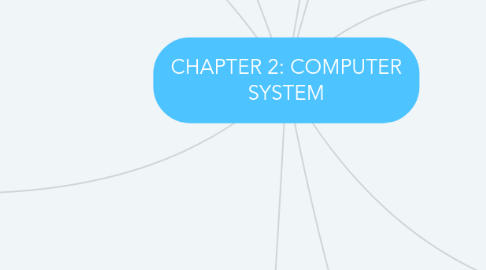
1. MOTHERBOARD
1.1. - is the main circuit board of the system unit, that contains integrated circuits
1.2. FUNCTIONS: i) Holds many components of the system ii) provides connectors for other peripherals
1.3. BASIC COMPONENT: 1) processor slot 2) memory slot 3) adapter card slot
2. PROCESSOR
2.1. - also called central processing unit (CPU)
2.2. COMPONENTS: control unit (CU) & arithmetic logic unit (ALU)
2.3. CONTROL UNIT (CU)
2.3.1. directs and coordinates most of the operations in the computer
2.4. ARITHMETIC LOGIC UNIT (ALU)
2.4.1. performs arithmetic, comparison and other operations include basic calculations such as addition, subtraction, multiplication and division
2.5. MACHINE CYCLE (FDES)
2.5.1. FETCH
2.5.1.1. the control unit obtain the instruction and data from memory
2.5.2. DECODE
2.5.2.1. the control unit translate the instructions into the signals the computer can perform
2.5.3. EXECUTE
2.5.3.1. the process of carrying out the commands
2.5.4. STORE
2.5.4.1. the results are kept in memory (RAM)
3. ADAPTER CARD
3.1. FUNCTIONS: enhances functions of a component of the system unit and/or provides connection to peripherals
3.2. FIREWIRE CARD
3.2.1. connects to firewire device (high-speed printer, video camera, digital camera)
3.3. MODEM CARD
3.3.1. connects other computers through telephone lines, cable television lines, or other transmission media (enable to access internet)
3.4. NETWORK CARD
3.4.1. communication device that enables a computer that does not have built in networking capability to access a network
4. SOFTWARE
4.1. -Series of instructions that tells a computer what tasks to perform and how to perform them
4.1.1. SYSTEM SOFTWARE - consists of the programs (set of instructions) that control or maintain the operations of the computer and its devices. - free
4.1.1.1. OPERATING SYSTEM
4.1.1.1.1. - a set of programs containing instructions that work together to coordinate all the activities among computer resources
4.1.1.1.2. FUNCTIONS
4.1.1.2. UTILITY PROGRAM
4.1.1.2.1. - a type of system software that allows a user to perform maintenance-type task
4.1.2. APPLICATION SOFTWARE - consists of programs (set of instructions) designed to make users more productive or assist them with personal task - license/paid
4.1.2.1. WEB BROWSER
4.1.2.1.1. PROPRIETARY SOFTWARE
4.1.2.1.2. OPEN SOURCE SOTWARE
4.1.2.2. WORD PROCESSING
4.1.2.2.1. PROPRIETARY SOFTWARE
4.1.2.2.2. OPEN SOURCE SOTWARE
4.1.2.3. SPREADSHEET
4.1.2.3.1. PROPRIETARY SOFTWARE
4.1.2.3.2. OPEN SOURCE SOTWARE
4.1.2.4. DATABASE
4.1.2.4.1. PROPRIETARY SOFTWARE
4.1.2.4.2. OPEN SOURCE SOTWARE
4.1.2.5. PRESENTATION
4.1.2.5.1. PROPRIETARY SOFTWARE
4.1.2.5.2. OPEN SOURCE SOTWARE
5. STORAGE
5.1. STORAGE: holds data, instructions, and information for future use
5.2. STORAGE MEDIUM: physical material on which a computer keeps data, instructions and information
5.3. MAGNETIC STORAGE: eg: hard disk- external hard disks, internal hard disk, removable hard disk
5.4. OPTICAL STORAGE: eg: compact disc (CD), digital video disc (DVD), blu-ray disc (BD)
5.5. FLASH MEMORY: eg: solid state drives (SSD), memory card, USB flash drives
6. INFORMATION PROCESSING CYCLE
6.1. INPUT
6.1.1. - the process of entering data into memory
6.2. PROCESS
6.2.1. - the process of transforming data into information
6.3. OUTPUT
6.3.1. - the process of conveying information to the user
6.4. STOARAGE
6.4.1. the operation of saving data, programs, intructions or output for future use
7. INPUT DEVICE
7.1. -any hardware component allows users to enter data and instructions into a computer
7.1.1. TYPE OF INPUT DEVICE
7.1.1.1. -KEYBOARD
7.1.1.2. POINTING DEVICE
7.1.1.2.1. mouse
7.1.1.2.2. trackball
7.1.1.2.3. touchpad
7.1.1.3. DIGITIZER
7.1.1.3.1. scanner
7.1.1.4. READING DEVICE
7.1.1.4.1. RFID (radio frequency identification) - e.g: tracking times of runners in a marathon
7.1.1.4.2. MICR (magnetic ink character recognition) - eg: bank check
7.1.1.5. BIOMETRIC INPUT DEVICE
7.1.1.5.1. fingerprint reader
7.1.1.5.2. face recognition system
7.1.1.5.3. iris recognition
8. OUTPUT DEVICE
8.1. - any hardware component that conveys information to one or more people
8.1.1. DISPLAY DEVICE
8.1.1.1. LCD monitor
8.1.1.2. Plasma monitor
8.1.2. VOICE OUTPUT DEVICE
8.1.2.1. Speaker
8.1.2.2. headphones
8.1.2.3. earbuds
8.1.3. PRINTERS
8.1.3.1. Ink-jet printer
8.1.3.2. Dot-matrix printer
9. MEMORY
9.1. FUNCTIONS: Store instructions to be executed by the processor
9.2. VOLATILE (RAM)
9.2.1. temporary: loses its contents when the power is turned off
9.2.2. can be read from and written to by the processor and other device
9.2.3. DRAM, SRAM, MRAM
9.3. NONVOLATILE (ROM)
9.3.1. permanently: does not lose contents when power turned off
9.3.2. data is prerecord for read only and cannot be modified or removed
9.3.3. PROM, EPROM, EEPROM

